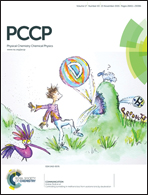Anion states and fragmentation of 2-chloroadenine upon low-energy electron collisions†
Abstract
We report on a joint theoretical and experimental investigation into the electron-induced fragmentation of 2-chloroadenine, for electrons up to 12 eV. Elastic scattering calculations indicate an anion spectrum comprising a σCCl* and four π* shape resonances, where the latter are systematically stabilised when compared to the analogue states of adenine. The measured ion yields indicate strong signals associated with the elimination of neutral hydrogen (peaking at 0.8 eV and with milder structures up to 2 eV), chloride ions and hydrochloric acid (both observed at around 0.2 and 0.9 eV). Bound state calculations indicate that the main feature for hydrogen abstraction arises from a vibrational Feshbach resonance on a dipole-bound state coupled to a σNH* state, while the π2* and π3* resonances initiate this fragmentation process in the 1–2 eV region. On the other hand, the C–Cl bond cleavage would mainly arise from the formation of the π1* and π2* resonances, which couple to the dissociative σCCl* state. Our results show that 2-chloroadenine efficiently dissociates into reactive species upon electron attachment, corroborating its potential as a radiosensitising drug.


 Please wait while we load your content...
Please wait while we load your content...